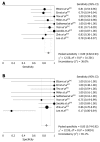Usefulness of CT angiography in diagnosing acute gastrointestinal bleeding: a meta-analysis
- PMID: 20712058
- PMCID: PMC2923771
- DOI: 10.3748/wjg.v16.i31.3957
Usefulness of CT angiography in diagnosing acute gastrointestinal bleeding: a meta-analysis
Abstract
Aim: To analyze the accuracy of computed tomography (CT) angiography in the diagnosis of acute gastrointestinal (GI) bleeding.
Methods: The MEDLINE, EMBASE, Cancerlit, Cochrane Library database, Sciencedirect, Springerlink and Scopus, from January 1995 to December 2009, were searched for studies evaluating the accuracy of CT angiography in diagnosing acute GI bleeding. Studies were included if they compared CT angiography to a reference standard of upper GI endoscopy, colonoscopy, angiography or surgery in the diagnosis of acute GI bleeding. Meta-analysis methods were used to pool sensitivity and specificity and to construct summary receiver-operating characteristic.
Results: A total of 9 studies with 198 patients were included in this meta-analysis. Data were used to form 2 x 2 tables. CT angiography showed pooled sensitivity of 89% (95% CI: 82%-94%) and specificity of 85% (95% CI: 74%-92%), without showing significant heterogeneity (chi(2) = 12.5, P = 0.13) and (chi(2) = 22.95, P = 0.003), respectively. Summary receiver operating characteristic analysis showed an area under the curve of 0.9297.
Conclusion: CT angiography is an accurate, cost-effective tool in the diagnosis of acute GI bleeding and can show the precise location of bleeding, thereby directing further management.
Figures



References
-
- Manning-Dimmitt LL, Dimmitt SG, Wilson GR. Diagnosis of gastrointestinal bleeding in adults. Am Fam Physician. 2005;71:1339–1346. - PubMed
-
- Barkun A, Bardou M, Marshall JK. Consensus recommendations for managing patients with nonvariceal upper gastrointestinal bleeding. Ann Intern Med. 2003;139:843–857. - PubMed
-
- Imdahl A. Genesis and pathophysiology of lower gastrointestinal bleeding. Langenbecks Arch Surg. 2001;386:1–7. - PubMed
-
- Lee EW, Laberge JM. Differential diagnosis of gastrointestinal bleeding. Tech Vasc Interv Radiol. 2004;7:112–122. - PubMed
-
- Longstreth GF. Epidemiology and outcome of patients hospitalized with acute lower gastrointestinal hemorrhage: a population-based study. Am J Gastroenterol. 1997;92:419–424. - PubMed

